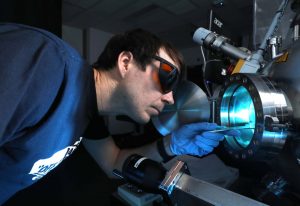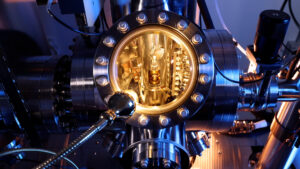- Innovative epitaxy technique creates a new phase of the popular multiferroic BiFeO3
Stress enhances the properties of a promising material for future technologies.
UNSW researchers find a new exotic state of one of the most promising multiferroic materials, with exciting implications for future technologies using these enhanced properties.
Combining a careful balance of thin-film strain, distortion, and thickness, the team has stabilised a new intermediate phase in one of the few known room-temperature multiferroic materials.
The theoretical and experimental US-Australian study shows that this new phase has an electromechanical figure of merit over double its usual value, and that we can even transform between this intermediate phase to other phases easily using an electric field.
As well as providing a valuable new technique to the toolkit of all international material scientists working with multiferroics and epitaxy, the results finally shed light on how epitaxial techniques can be used to enhance functional response of materials for future application in next -generation devices.
Stress changes everything

The direction of deformation of a thin film depends on its relative structural size compared with the substrate beneath. Left: If structural units of the substrate (coloured squares) are larger than those of the thin film (empty squares), the film stretches horizontally and compresses vertically. Right: A smaller substrate structure cause the film to be compressed horizontally and stretched vertically.
If 2020-21 has taught us anything, it’s that stress changes everything. Even the most ‘together’ person can struggle and change given enough stress in their life.
The same applies for crystals, too. When we apply stress to crystals, they become strained and can change their structure and physical properties dramatically. We utilise this in everyday technology, using external stimuli to bend material properties at will.
When we impose strain on a material, we are usually pushing together or pulling apart along (at least) one axis, creating compressive and tensile strain.
When we strain thin films on substrates, the building blocks of the film will deform to match the sizes of the building blocks of the neighbouring substrate.
If the structural units of the substrate are larger than those of the thin film (the blue square), the film (white outline) will stretch horizontally (ie, ‘tensile strain’) and compress vertically to fit.
On the other hand, a smaller substrate structure cell (green square) will cause the film structure to be compressed horizontally (‘compressive strain’) and stretched vertically.
“In our research, we applied anisotropic strain to our film. This means that the strain applied is different depending on which direction you’re looking, and this can create complicated strain states that force films into new phases,” says first author Oliver Paull (UNSW).
It’s magnetoelectric, it’s piezoelectric, it’s photovoltaic… it’s greased lightning!

BFO’s impressive range of magnetoelectric properties—including piezoelectricity, ferroelectricity, magnetism, and optical properties—make it a popular material for researchers investigating spintronics, memory applications and low-energy technologies. Image: characterising BFO at 20nm/50nm thicknesses on varying oriented substrate.**
BiFeO3 (or BFO) boasts an impressive resume of multifunctional properties, including piezoelectricity, ferroelectricity, magnetism, and optical properties.
BFO is arguably the most popular magnetoelectric material for researchers (ie, a material that has both magnetic and electrical ordering that can influence each other).
Magnetoelectric materials are highly interesting for spintronics and memory applications since the coupling between magnetism and ferroelectricity promises low energy technologies. (Writing data with an electric field is much more efficient than writing with magnetic field.)
Not only is BFO magnetoelectric, but it is one of the very few materials that is magnetoelectric at room temperature, making it viable for use in applications such as future low-energy electronics, without the requirement for energy-intensive cryo-cooling.
Only very few multiferroic materials (ie, materials that have both magnetic and electrical order) exhibit these useful properties at room temperature.
In addition to this, BFO boasts other functional properties: piezoelectricity, ferroelectricity, photovoltaic effects, and more!
It’s also lead free, giving it a clear advantage against most high-performing piezoelectric materials, which unfortunately contain toxic lead.
Piezoelectric materials, which can convert mechanical pressure into electrical energy, have wide applications as ultra-high-sensitivity sensors in devices such as smartphone motion sensors and pacemakers (where obviously avoiding toxic materials is an advantage…).
By using highly miscut substrates, the research team pushed BFO into a new phase that is essentially the link between the well-known rhombohedral-like and tetragonal-like phases.
This, coupled with the symmetry-related properties of the phase, allows it to be easily influenced by electric fields.
“We looked through the literature and found that everyone uses fairly standard commercial substrate orientations,” says head investigator Daniel Sando. “We asked our providers to custom-make different miscut orientations in between the standard orientations, which led to the discovery of the new phase. We asked ourselves if the reason people hadn’t done this before is that the crystallography involved with these miscuts is rather complex and can be intimidating!”
The international collaboration between researchers at Oak Ridge National Lab, University of Arkansas, and Monash University, used theoretical calculations and a suite of experimental techniques to show that this new phase has a much higher electromechanical response than traditional BFO.
“We additionally show strong evidence that this low-symmetry phase can be converted into a higher-symmetry phase using an electric field, and as a result can enhance the electromechanical response even further by a factor of 3,” says Oliver Paull.
A multipurpose tool: applying the approach to a broad range of oxide materials
One of the most appealing aspects of this discovery is its general methodology and applicability to a broad class of materials systems.
“We chose to focus on BiFeO3 due to its ferroelectric, magnetic, and piezoelectric properties, but the approach is easily applied to other perovskite oxides,” says Oliver Paull.
“We are currently exploring the effect of these high-index substrates on purely ferroelectric or magnetic systems, but the scope for using this technique is huge. We expect to find low symmetry phases of optically interesting materials, as well as novel domain arrangements in ferroelectrics, to name a few,” noted Laurent Bellaiche, the theoretical lead on the project.”
“If you’re dealing with epitaxy, then this anisotropic technique could prove very fruitful for your research,” says Daniel Sando.
“This study is just the beginning. We plan to combine this anisotropic epitaxy approach to oxide superlattices (repeating layers of different compositions, i.e. A-B-A-B etc.), as well as combining the low symmetry crystal structures with other established routes for improving piezoresponse, including substitution with rare earth elements, for example. Finally, since BFO is multiferroic, we have a raft of magnetic studies planned for this new low-symmetry phase.” Says UNSW lab leader Nagy Valanoor.

Characterising thin-film BFO (left) with scanning tunnelling microscope, and (right) strain map of the dashed white box area.**
There are even broader possible applications: Piezoelectrics used in sensors and actuators are typically lead-based compounds in bulk form. While the new approach is niche and very research-oriented, there could be scope for the new methods to work in such industries as nano-actuators or sensors. The key aspect is the use of the anisotropic epitaxy approach to 1) generate a low-symmetry phase, and 2) facilitate enhancements in response; in this case, the piezoelectric coefficient.
The study
“Anisotropic epitaxial stabilization of a low-symmetry ferroelectric with enhanced electromechanical response” was published in Nature Materials in September 2021. (DOI: 10.1038/s41563-021-01098-w) Full access link (Springer Nature Content Sharing Initiative).
The research is a large international collaboration between UNSW (film fabrication and characterisation), the University of Arkansas (density functional theory and effective Hamiltonian calculations), Oak Ridge National Lab (advanced scanning probe microscopy techniques), and Monash University / ARC Centre of Excellence for Advanced Molecular Imaging (scanning transmission electron microscopy).
As well as support by the Australian Research Council (Centre of Excellence and Discovery programs) the work was funded by the Australian Government (Research Training Program Scholarship), the Australian Institute for Nuclear Science and Engineering (AINSE) (Post-graduate research award, and SAAFE), DARPA (TEE Program) and Vannevar Bush Faculty Fellowship (VBFF).Facilities within the Monash Centre for Electron Microscopy (MCEM) were funded by Australian Research Council (LIEF) and piezo-response spectroscopy measurements were supported by the US Department of Energy (DOE) and performed at Oak Ridge National Laboratory’s Center for Nanophase Materials Sciences (CNMS). Thanks for financial support from National Natural Science Foundation of China and the Natural Science Foundation of Jiangsu Province. The authors thank C. Paillard for fruitful discussions and for sharing his scripts, and L. Collins for assistance with the IDS measurements.
** images from Nature Materials DOI: 10.1038/s41563-021-01098-w
More information
- Contact Dr Daniel Sando (UNSW, Sydney) daniel.sando@unsw.edu.au
- Read novel material news at FLEET.org.au
- Watch Future solutions to computation energy use
- Connect @FLEETCentre




